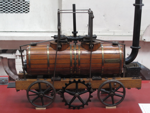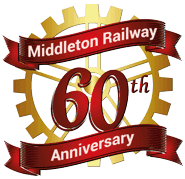General
Wagon LMS 85133
Goods van
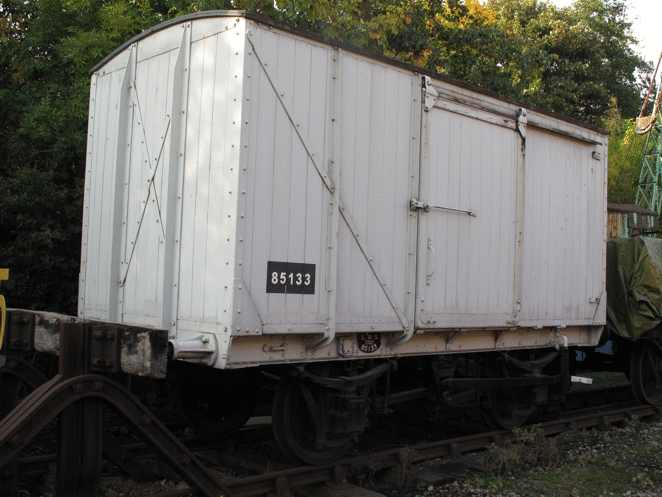
| Built | London Midland and Scottish Railway, 19?? |
| Load capacity | 12 tons |
| Length over buffers | 20' 6" (approx 6.2 metres) |
| Previously worked | LMSR, and then British Railways Midland Region |
| Entered collection | Purchased from British Railways in 1963 |
| Current status | Operational |
More details of our rolling stock collection are given in our stockbook.
Go on to goods wagon W113084.
Return to the list of goods wagons.
More Information
Other pages provide more information about:
Raising Steam In No. 6
This page contains the following information about ‘No. 6’.
- A brief history of it;
- A description of the overhaul that had been started; and
- An explanation of what was needed to finish this overhaul, and why we had needed to set up an appeal for funds.
For the record, a separate page gives the details of this appeal, which is now closed.
History
‘No. 6’ was built in 1935 by R & W Hawthorn Leslie, and it spent its entire working life at APCM's Cement Works in Swanscombe, Kent, along with six similar locomotives. Here it hauled chalk from the quarry face to the factory, and loads of cement from the factory both to the main line railway sidings, and to APCM’s wharf on the Thames Estuary. The picture below shows it when working at Swanscombe, hauling a train of wagons of chalk past the tippler.
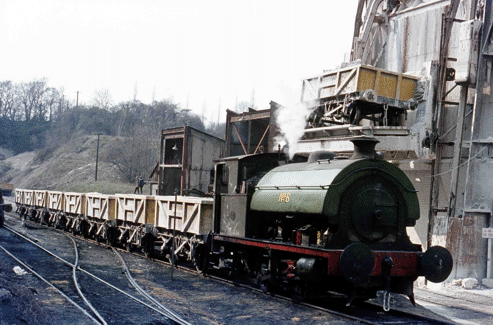
[Picture from the MRT's photo archive, taken by Ernie Brack]
In 1971, when the steam locomotives were replaced by diesels, APCM donated two of them for preservation, and No. 6 came to the Middleton Railway. It arrived on 5th June of that year, and the picture below shows it being unloaded from the low loader that had transported it to Leeds, onto the headshunt opposite the Parkside ground of the Hunslet Rugby League club.
The two sets of road wheels to the right of the picture were from the back of the low loading trailer, and once this had been jacked up then they had to be taken off to allow lengths of rail to be connected to the ones on the deck of the trailer, so as to form a ramp down which the locomotive could be run. The diesel locomotive "Carroll" (HC D631) is waiting with a runner wagon, which would be run up the ramp to couple on to the locomotive, so as to control its descent. Then "Carroll" would tow it up the gradient to Clayton's Dartmouth yard, which at that time was the railway's operating headquarters.
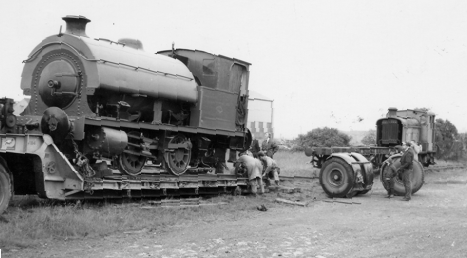
[Picture from the MRT's photo archive, taken by John Edwards]
Soon after its arrival, once the chalk had been cleared out of some of its fittings, No. 6 was able to enter service. Not long after this the picture below shows it being towed by "Carroll" along the new Dartmouth branch, which had replaced the old branch and the Parkside headshunt as part of the construction work on what is now the M621 motorway. This construction work can be seen in the background of this picture.
Quite why No. 6 was not in steam on this occasion, or was needing to be towed by "Carroll", is not clear. Presumably it had been on display for some purpose at the Moor Road platform, but we have no record of what that purpose was. One speculation is that it might have been when APCM presented us with a plaque to be fitted to the rear of the cab.
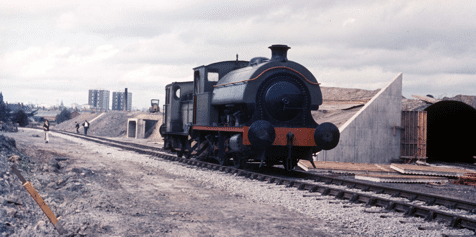
[Picture from the MRT's photo archive, taken by Keith Halton]
For the next few years No. 6 played a major part in operating the railway's passenger trains, as shown in the picture below. Here it is seen in 1972, propelling a passenger train across the footpath crossing at what is now the south end of our Moor Road yard.
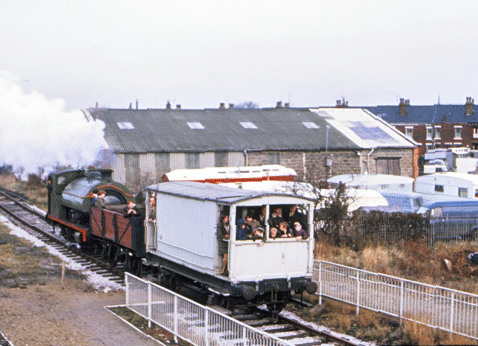
[Picture from the MRT's photo archive, taken by David Hebden]
No. 6 continued to operate until 1975, but at the end of that year it had to be taken out of service, awaiting an overhaul. For various reasons this became a long wait, but eventually its turn came in 2001, and it was brought into the workshops.
Starting the Overhaul
As with any overhaul, the first stage was to remove the tanks and boiler cladding, and the saddle tank was placed in storage on top of one of the containers in the yard. Then the boiler was lifted out of the frames, and work started on dismantling the chassis and running gear. These required a lot of attention, but by 2005 the overhaul of them had reached a stage where it was appropriate to start work on the boiler.
This, however, was also the year when the complete remodelling of the Moor Road site began, along with the construction of the Engine House building. These projects needed huge amounts of volunteer input, and so work ceased on the overhaul of No. 6. Since then its chassis has remained in the workshop, with just occasional bits of progress being made, and the picture below shows it there, underneath the lifting gantry.
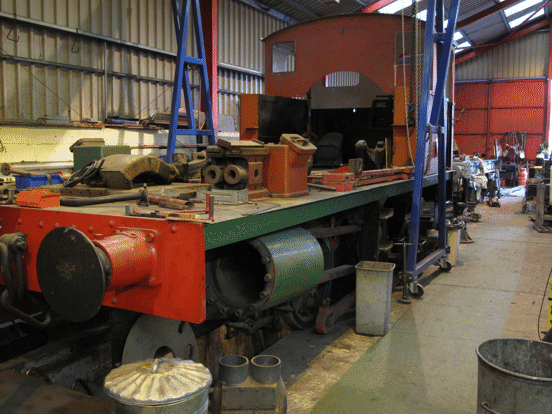
[Picture from the MRT's photo archive, taken by Tony Cowling]
Meanwhile, inspection of the boiler had revealed that some major repairs would be needed, and advice on these was sought from Gordon Newton, formerly of the boilermakers Israel Newton and Sons. He visited the railway during 2014, and gave advice not only on what work was needed, but also on how much of this our members could sensibly undertake themselves. Specifically, he identified that on both sides of the firebox sections of the outer wrapper plate would need to be replaced, because they had been corroded by the hard water when working at Swanscombe.
The first stages in replacing these plates would be to remove the stays from the affected sections of the firebox, then cut out the centre sections of the corroded pieces of plate, and finally drill out the rivets so as to remove the rest of each part of the plate. His advice was also that this was all work that our members could do, and that doing it ourselves would reduce significantly the cost of the whole overhaul, and so he gave us detailed instructions on how to do it. We did all the work that he described, and the pictures below show the boiler upside down on a trolley, with the two corroded plates removed from the sides of the firebox.
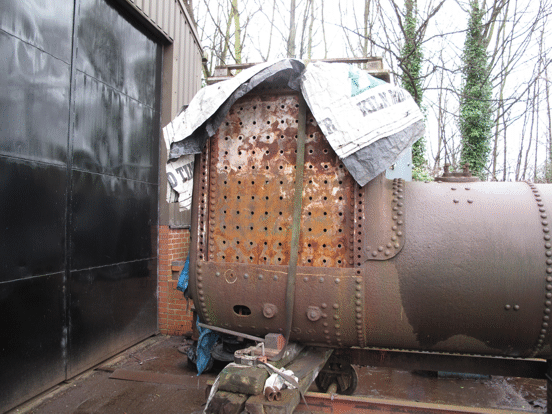
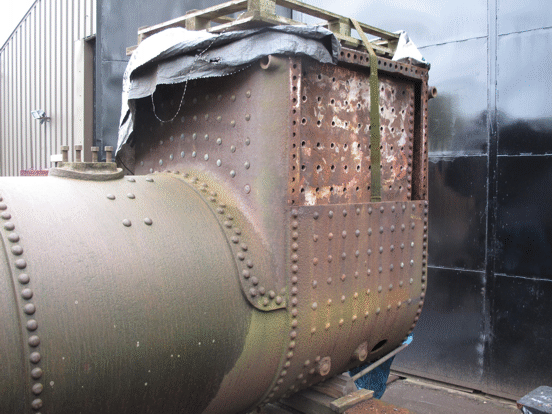
[Pictures from the MRT's photo archive, taken by Tony Cowling]
Finishing the Overhaul
Our aim was still to return the locomotive to steam by 2020, when it would be 85 years old. As a minimum this would require new plates to be made and fitted, with new stays to replace the ones that had been removed. Then a new set of boiler tubes would have to be fitted. The work might possibly have also involved replacement of some of the firebox crown stays, but fortunately this turned out to not be needed. Consequently, even though we had done as much of the work ourselves as we could, it was conservatively estimated that £60,000 would be required to do all of the work that was still needed in order to complete the overhaul of ‘No. 6’.
We therefore launched an appeal to raise the funds needed to achieve all of this, and a separate page gives more details of this appeal. We have now closed this appeal.
Meanwhile, we had re-started work on the chassis of the locomotive, and a separate page describes the start of the work to finish off the overhaul of No. 6.
The other pages that give more information about this project are therefore as follows:
- Overhaul of No. 6 Part 1, which describes the start of the work that had to be done to finish this overhaul.
- Overhaul of No. 6 Part 2, which describes the completion of the work that had to be done to finish this overhaul.
- Help Raise Steam in No. 6, which describes the appeal that was for funds to help finish this project.
More Information
Pages about other projects:
- Last Coals to Leeds;
- Project Phoenix;
- Building a Running Shed;
- Overhauling "Brookes No. 1";
- Conserving "Picton";
Other pages provide more information about:
Rolling Stock - Coaches
Historically the Middleton Railway only transported goods - mainly coal - and so it had no need of passenger coaches. When we started to operate passenger trains, we initially had to use a goods brake van and an open wagon, as the only available vehicles, but since then we have converted several parcels vans into the passenger coaches that we now use. They are identified in our collection by the running numbers that they used to carry as parcels vans, and there are three of them, which in the order in which they came into service are as follows.
As well as these we also have two goods brake vans, which were built originally to carry the guard of a goods train, and to provide additional braking power in the days before goods trains had brakes on all vehicles that could be controlled by the driver. These brake vans are sometimes used to carry passengers when we are running mixed trains (ones that consist of both passenger and goods vehicles) as part of special events. Again, these vans are identified by the running numbers that they used to carry when they were in use on British Railways, and they are as follows.
The pages for these coaches and vans give a brief overview of our collection, but for more information about it our stock book is available in the shop. Click here for more details of this.
Return to the page for our museum collection.
More Information
Pages about other categories of museum exhibits:
Other pages provide more information about:
Help Raise Steam in No. 6
For the record, this page contains the following information about the appeal to return ‘No. 6’ to steam. This appeal is now closed.
- The current progress with the overhaul project, when the appeal was set up
- What work still needed to be done;
- How you could have helped with the appeal; and
- The current progress with the appeal.
A separate page contains the following information about the locomotive itself.
- A brief history of it;
- A description of the overhaul that had been started; and
- An explanation of what was now needed to finish this overhaul, and why we had needed to set up an appeal for funds.
Current Progress of the Project
The overhaul of No. 6 (Hawthorn Leslie 3860) had become a very major project. Perhaps not as major as those overhauls that have involved constructing complete new locomotive boilers, but it was not far behind them in size and cost, which is partly why there was such a long delay before it was even started.
As explained in the separate page that describes the history of the locomotive, the overhaul of the chassis was a substantial piece of work, as it involved stripping it down almost completely, and even replacing some of the rivets that held the frame plates together. Beyond that, we had never previously had to do any work ourselves on a boiler that involved replacing parts of the platework.
For the boiler work we did as much ourselves as we were able to do, by removing the corroded sections from both sides of the firebox wrapper plate, and taking the tubes out of the boiler, leaving it as shown in the pictures below. But the rest was going to require large amounts of money, which is why we needed to raise funds to enable us to complete the work.
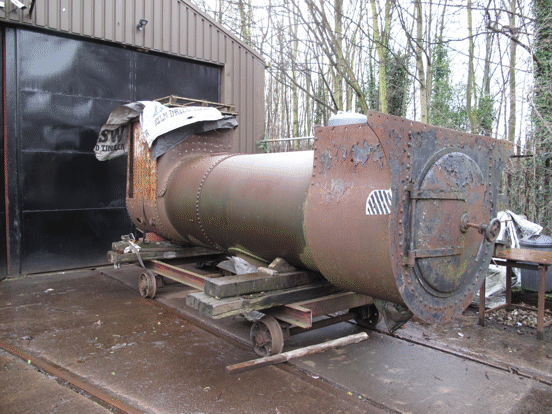
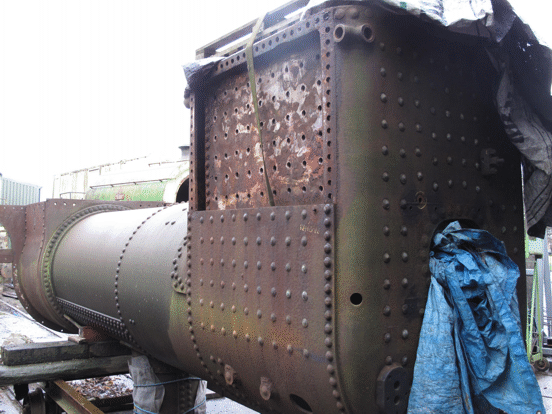
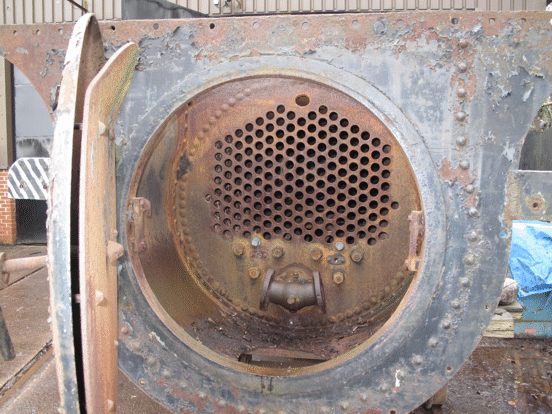
What Needs to be Done
From this point on, the boiler would have to be sent away so that all of the remaining repairs to the boiler could be done by skilled boilermakers, and their work is not cheap. When the repaired boiler would eventually be returned to us then some work would be needed to finish assembling the locomotive, and this would involve some costs, as well as volunteer effort.
Hence, our initial estimate was that completing the overhaul would probably cost about £60,000. This was far more than we could budget for locomotive repairs as part of our normal operation, which is why we started an appeal for funds to enable us to return No. 6 to steam.
Specifically, our aim in this appeal was to raise as much of this sum as we could, in time to have the locomotive back in steam for 2020, when it would be 85 years old. We were looking forward to seeing it running again as it was in the picture below (taken in 1971, when the motorway was still under construction).
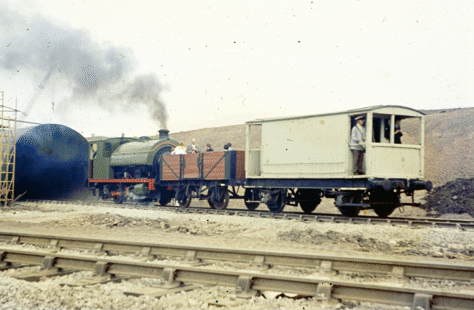
[Picture from the MRT Photo Archive, taken by Ian Smith]
How You Could Have Helped
We have now closed the appeal, but while it was running you could have helped us either by buying one or more of the parts that were needed, or by contributing to the cost of the work involved in doing the repairs. For instance:
- £2.50 would buy us one of the many rivets that were needed for fitting the new firebox plates;
- £20 would buy us a new stay for the firebox (and we needed 153 of them);
- £25 would buy us a new tube for the boiler (and we needed 170 of them);
- £40 would cover the cost of installing one of the new stays in the fire box (and we didn't try to count them!);
- £45 would cover the cost of installing one of the new tubes in the boiler;
- bigger sums than this would help contribute to the specialist work required to replace the fire box side plates.
Current Progress of the Appeal
The amount that this appeal raised will be shown here shortly.
Our thanks to everybody who has contributed so far.
The other pages that give more information about this project are as follows:
- Raising Steam In No. 6, which describes the history of the locomotive and the overhaul that had been started.
- Overhaul of No. 6 Part 1, which describes a lot of the mechanical work that had to be done to finish this overhaul.
- Overhaul of No. 6 Part 2, which describes the remaining work that had to be done, once the boiler had been sent away, in order to complete this overhaul.
More Information
Other pages provide more information about:
S5: Hudswell-Clarke 1309
0-4-0ST steam locomotive, "Henry de Lacy II"
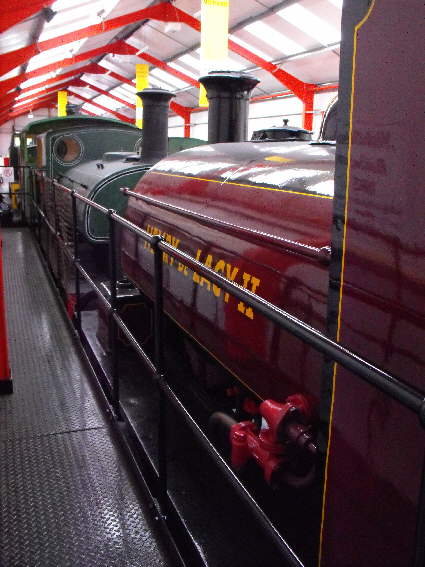
| Built | 1917, at Leeds |
| Weight | 28 tons 5 cwt |
| Length over buffers | 23' 1" (approx 7.0 m) |
| Driving wheels | 3' 4" diameter (approx 100 cm) |
| Cylinders | 2 (outside), 14" diameter (approx 355 mm) |
| Previously worked | Kirkstall Forge, Leeds |
| Entered collection | Donated by Kirkstall Forge in 1968 |
| Current status | On display, but not operational |
More details of this locomotive are given in our stockbook.
Go on to steam locomotive S6: Hawthorn Leslie 3860.
Go back to steam locomotive S3: NER '1310'.
Return to the list of steam locomotives.
More Information
Other pages provide more information about:
Subcategories
Projects
Projects and appeals.
Volunteering
For pages related to volunteering and membership

